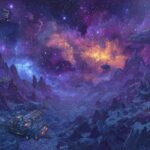Dragon Quest VII Reimagined isn’t just a reimagining of the late PlayStation 1 era JRPG, it’s also a fresh approach to how Square Enix’s back catalogue can be revisited. We’ve had the pixel remasters of early Final Fantasy, we’ve had the HD-2D engine applied liberally to the original Dragon Quest trilogy, and there is, of course, the vast production for the Final Fantasy VII Remake trilogy. Dragon Quest VII, though, has been treated in a new, distinct fashion, and I love how it’s turning out.
Simply put, Dragon Quest VII Reimagined looks like dolls wandering around a diorama. Square Enix created these characters as real-life, physical dolls and then 3D-scanned them into the game to really capture the look, giving them a slightly otherworldly feel, but one that’s uniquely charming. They’re still animated as you’d expect from characters in a video game, as opposed to bobbing around like marionettes in a Thunderbirds episode, and combined with the style of the environments you get to explore, it comes together beautifully to help this remake stand out from the crowd.
My hands-on demo time took me to two early portions of the game, visiting the village of Emberdale just as it’s being shaken to its core by earth tremors. They think they’ve got it all in hand – just go ahead as usual with the Fire Festival to head up Burnmont to tribute to and appease the gods – but one of the village elders thinks otherwise and enlists you to try and help. As everyone troops up to the volcano and chucks flaming headgear down into the pit, you instead skirt past and descend into the magma tunnels to find the truth of the matter.
Just as with the Nintendo 3DS remake of this game, Dragon Quest VII Reimagined does away with the randomised battle encounters and instead has all the enemies appearing in the overworld. It’s a significantly more modern approach that helps to ease some of the pain of running around and exploring the world, and gives you the chance to sneak up or time a Sudden Strike attack while still in the main game world.
This comes in tandem with a bunch of other quality-of-life improvements that are now fairly typical for RPG remakes, but always good to see. There’s a bevy of party automation which can be applied across all the characters or individually, giving them battle tactics to be more aggressive or defensive, to us magical abilities or focus on healing. This is already a massive time saver for basic encounters, but you can also speed up battles, dip in and out if battles are going to plan or not, and it’s just great to be able to cut through to the more meaningful moments.
You’ll still have plenty to do, though, thanks to the expanded Vocation system, allowing all the characters to ‘moonlight’ with a different class, blending their abilities together instead of entirely switching. Periodically in combat, this will also lead to characters getting ‘Worked Up’ and being able to unleash a powerful, vocation-specific attack, buff or ability that you can set up to aid your party composition. These can be really useful when toughing it out in a beastly boss battle.
Jumping ahead in this adventure to the town of Wetlock, and the townsfolk have been captured by a man doing his best Pied Piper impression. Another bad guy to battle, eh? Well, not all is as it seems, and after battling some real hordes of slimes and other monsters – some of which combine themselves in large numbers, call in reinforcements and more – you get the truth of the matter. Wetlock has been flooded, but it wasn’t this old chap; he was actually saving people from the evil merman Gracos.
Once you reach him, Gracos proves to be a stern challenge, and it’s for these moments that you really want to pull back some of the automation and take more manual control to pick the best abilities, choose when to heal or defend, and generally make every moment count. The party has become more varied thanks to the addition of the wolf-raised Ruff and the battle dancing Aishe, and being deeper into the game means that there’s a huge array of abilities and spells to choose from across the board. Finding the most effective abilities, buffing the team and staving off Gracos’ worst is a fun juggling act.
Dragon Quest VII Reimagined is shaping up to be another fantastic remake from Square Enix. It’s a bit bewildering just how many different styles and approaches they’ve taken to revisiting their classics, but this takes a wonderful art direction and combines it with a great set of quality-of-life improvements while tweaking it to address the biggest criticisms. All in all, it should be the best way to revisit this adventure when it arrives next year.






